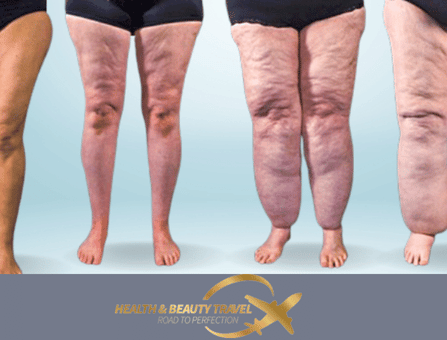H. Hartplein 33 A
5462EB Veghel NL
5462EB Veghel NL
Monday – Saturday – 8:00 – 18:00
Sunday – 8:00 – 14:00
Sunday – 8:00 – 14:00

What is the treatment of lipedema and how is it performed?
Lipedema is a chronic disorder of adipose tissue that occurs mainly in women.
This condition is characterized by abnormal fat accumulation, especially in the lower body, such as the legs and hips.
However, this fat accumulation differs from normal weight gain.
The legs of patients with lipedema become excessively swollen, and the fatty tissue is noticeably firm.
Lipedema is also accompanied by symptoms such as pain, increased risk of bruising and tenderness.
This disease is not only a cosmetic problem, but can also cause physical discomfort and mobility limitations.
Therefore, treatment of lipedema is essential because early intervention can slow the progression of the disease and improve quality of life.
The first and most crucial step in treating lipedema is proper diagnosis.
This condition is often confused with obesity or lymphedema.
However, lipedema does not easily respond to diet and exercise.
Therefore, an accurate diagnosis is vital to guide patients to the right treatment.
There are several methods available to treat lipedema.
The first of these are conservative treatments, such as manual lymphatic drainage.
This therapy helps eliminate excess fluid that has accumulated in the body and reduces swelling.
In addition, compression therapy is a common method of treating lipedema.
Compression stockings or bandages increase pressure on the legs, reducing swelling and improving the patient’s mobility.
This method can slow the progression of lipedema and relieve symptoms.
Another method used in the treatment of lipedema is exercise.
Low-impact sports, such as swimming and cycling, can help relieve the symptoms of lipedema.
Such exercises improve blood circulation in the legs and help reduce swelling.
However, the exercise program for patients with lipedema should be designed by a specialist and tailored to the patient’s condition.
Treatment of lipedema is not limited to medical procedures.
Patients must also make lifestyle and dietary changes as part of treatment.
Anti-inflammatory diets, in particular, can help relieve the symptoms of lipedema.
These diets involve avoiding foods that can cause inflammation in the body.
Foods such as sugar, processed foods and refined carbohydrates are among those that patients with lipedema should avoid.
Instead, fresh vegetables, healthy fats and high-fiber foods can help manage the condition.
Treatment of lipedema requires a multifaceted approach to slow the progression of the disease and improve patients’ quality of life.
When conservative treatments, surgical procedures and lifestyle changes are used together, the progression of lipedema can be halted and symptoms relieved.
Heilig Hartplein 33A, 5462 EB Veghel NL
Maandag – Zaterdag – 8:00 – 18:00
Zondag – 8:00 – 14:00
info [@] healthandbeautytravel.nl
Maandag – Zaterdag – 8:00 – 18:00
Zondag – 8:00 – 14:00
info [@] healthandbeautytravel.nl